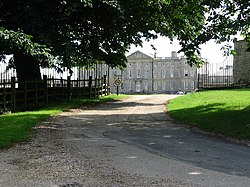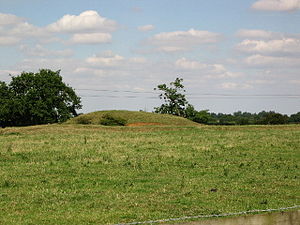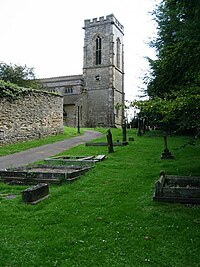Burley on the Hill
| Burley on the Hill | |
| Rutland | |
|---|---|
 Burley on the Hill Mansion | |
| Location | |
| Grid reference: | SK882104 |
| Location: | 52°40’48"N, 0°42’0"W |
| Data | |
| Population: | 577 (2001) |
| Post town: | Oakham |
| Postcode: | LE15 |
| Dialling code: | 01572 |
| Local Government | |
| Council: | Rutland |
| Parliamentary constituency: |
Rutland and Melton |
Burley-on-the-Hill is a village in Rutland, found two miles north-east of Oakham.
In the parish, north of the village, is Alstoe, the site of a possible small motte-and-bailey castle.[1] Alstoe gave its name to the county’s Alstoe Hundred.
In 1379 Sir Thomas le Despenser granted the Burley manor to trustees, two of whom were his brother Henry, Bishop of Norwich and his nephew Hugh le Despenser. Thomas died without issue in 1381, when at the outbreak of the Peasants' Revolt, Henry was at Burley and travelled to Norwich to confront the rebels.[2]
The Old Smithy on the village green was used in advertisements for Cherry Blossom shoe polish in the 1920s.
Ashwell Prison stood about one mile west of the centre of the village. Previously the site was a wartime American army base, home to part of the 82nd Airborne Division of the United States Army. The prison closed in March 2011 and has been redeveloped as Oakham Enterprise Park, a business park for office and light industrial use.
Church
The church of the Holy Cross, adjacent to the mansion, is in the care of the Churches Conservation Trust. It contains a moving memorial by Sir Francis Chantrey to Lady Charlotte Finch (1820).[3]
Burley-on-the-Hill House
Burley-on-the-Hill House is a mansion in the village overlooking Rutland Water. The house in the manner associated with Sir Christopher Wren, was built in the 1690s[4] by the 2nd Earl of Nottingham, who was to a large extent his own architect and involved himself in the minutiae of construction, but employed Henry Dormer (died 1727) to supervise its building. Nottingham replaced Dormer with John Lumley in 1697.[5] Before embarking on the project, Lord Nottingham consulted Sir Christopher Wren and had measurements taken at Berkeley House and Montagu House in London.[6] The house, in an H-plan, has a pedimented central block and lightly projecting end pavilions. With its symmetrical wings and outbuildings forming a cour d'honneur, and segmental walling linking matching blocks in a larger outer grassed court, it forms one of the most ambitious aristocratic ensembles of the late seventeenth century.
A dining room was designed for the 8th Earl of Winchilsea, and installed in 1778.[7]
In 1908, a fire broke out during a party attended by Winston Churchill, destroying the west part of the house.
The mansion was converted into 6 dwellings by Kit Martin in 1993–98, with a further 22 dwellings on the estate.
Cricket venue
George Finch, 9th Earl of Winchilsea, lived at the mansion in the late 18th century and used its grounds to stage a number of cricket matches, six of them first-class, between 1790 and 1793.[8] As late as 1814, the Park was used for a Rutland v Nottinghamshire game.
Outside links
| ("Wikimedia Commons" has material about Burley on the Hill) |
References
- ↑ Early Castles in the Mediæval Landscape of Rutland Oliver Creighton; p26-8
- ↑ A History of the County of Rutland - Volume 66217 : 66217 (Victoria County History) - 'Parishes: Burley', A History of the County of Rutland: Volume 2 (1935), pp. 112–119
- ↑ Rupert Gunnis, Dictionary of British Sculptors 1660–1851 rev. ed., 1968, s.v. "Chantrey, Sir Francis: Memorials".
- ↑ Foundations were laid in 1694 (H. J. Habakkuk, "Daniel Finch, 2nd Earl of Nottingham: His House and Estate", J. H. Plumb, ed. Studies in Social History 1955).
- ↑ Habakkuk 1955.
- ↑ Howard Colvin|Colvin, Howard, A Biographical Dictionary of British Architects, 3rd ed. 1995, s.v. "Dormer, Henry".
- ↑ A suite of reception rooms designed by Joseph Bonomi for Lord Winchilsea, 1782, were never carried out. (Colvin 1995, s.v. "Bonomi, Joseph", "Johnson, John".).
- ↑ List of matches
- A Vision of Britain through time - Burley
- Howard Colvin, A Biographical Dictionary of British Architects, 1600–1840, 3rd ed. (Yale University Press) 1995

